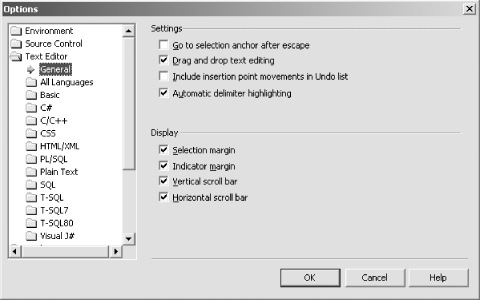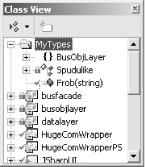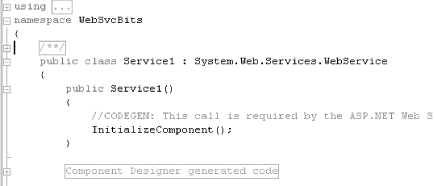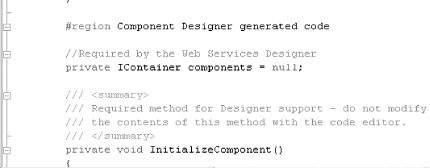|
|
|
2.1 Text EditorVisual Studio .NET provides a text editor that provides the basic source code editing facilities that are common to all languages. Each language service can extend the text editor to provide language-specific features. (See Chapter 10 for information about how language services extend VS.NET.) As well as supplying the basic text editing services, the editor also has hooks that allow language services to provide advanced features, such as IntelliSense and automatic formatting. Even though the exact way in which these services work is language-specific, the IDE provides the basic framework so that the behavior is as consistent as possible across languages. You can configure the way the text editor behaves for each language.
When a particular language takes advantage of a standard editor
feature such as IntelliSense, you will be able to configure that
feature's behavior either globally or, if you
prefer, on a per-language basis. Most languages also have their own
unique configuration options. You can edit all of these options by
selecting Tools Figure 2-1. The Text Editor Options dialog box Visual Studio .NET provides many coding aids to make editing your source code easier. The following sections describe each of these features. 2.1.1 IntelliSenseVisual Studio .NET provides a number of context-sensitive autocompletion features, collectively referred to as IntelliSense. VS.NET relies on the language service for the file you are editing to work out which symbols are in scope and uses this to show pop-up lists of suggestions, to show information in ToolTips or to autocomplete your text. Four varieties of assistance are offered by IntelliSense. All of them
can be invoked manually from the Edit
You can find the member you want in the list by typing in the first few letters of the member until the member is highlighted or by selecting the member with the mouse or arrow keys. When available, VS.NET will display brief documentation for the currently selected item in a ToolTip next to the list. Once you have highlighted the member you would like to use, VS.NET can enter the member name into your code for you. Either double-click on the item or just type any character that would not be allowed in an identifier (e.g., any of (, ., ;, Space, or Enter). Alternatively, you can execute the Complete Word command (see later). The List Members command executes automatically if you type in a variable name followed by the character for member access or object dereferencing (usually ., ->, or ::). However, the list will disappear if you start doing something else (e.g., you click to move the cursor elsewhere) so this shortcut is useful for bringing it back. Also, if you select the wrong item by accident, pressing Ctrl-J will reopen the list with your current selection highlighted, allowing you to move to the item you meant to select.
Some other autocompletion features are provided by the C# language service. Automatic skeleton insertion for interfaces and virtual methods is described later in this chapter (in the Section 2.1.5 section). Help is also provided with event handlers. (This feature is not available in VS.NET 2002.) If you write the += operator after an event member name (e.g., myButton.Click +=), a tooltip will appear offering to add code to create an appropriate delegate if you press Tab. If you go ahead and press the Tab key, it adds the appropriate code (e.g., new EventHandler(myButton_Click);). At this point a second tooltip will appear, offering to create a skeleton function whose signature matches the delegate and with a name matching its suggestion in the first completion. (So in this case, pressing Tab a second time would add a function called myButton_Click, with the correct signature for a Click event handler.) 2.1.2 C# DocumentationThe C# programming language lets you put special comments in the source code that can be used to generate documentation. These comments must begin with three slashes instead of the normal two and must be in an XML-based format. The XML is typically converted into HTML-based documentation for your solution. However, the XML can also be used by IntelliSense to provide pop-up documentation for types and their members. It uses the summary element for this, so you should always keep that part fairly succinct. The following code snippet shows a typical example of this documentation: /// <summary> /// The main entry point for the application. /// </summary> [STAThread] static void Main( ) If you type three slashes into the source editor in a C# file (or /**, which is the other way of indicating that a comment contains XML documentation), you will find that Visual Studio .NET automatically provides an XML skeleton for your documentation. This will always include a summary element, but if you put the comment before a method, VS.NET will also add elements for each parameter and for the return type. VS.NET also provides IntelliSense pop ups for the XML, telling you which elements are supported for the item you are documenting. (A complete description of the supported elements can be found in C# in a Nutshell (O'Reilly and Associates) and also in the C# Language Specification in the MSDN Library.) IntelliSense will automatically use this documentation if it is
present, but you must explicitly ask for HTML documentation to be
built if you want it. You do this using Tools
2.1.3 BeautifierVS.NET can reformat the currently selected portion of a file. The exact behavior of this feature is controlled by the language service. This feature is not available for certain file types (such as text files). To invoke this feature, first select the region of text you would
like to reformat (if you want to reformat the entire file, use Ctrl-A
or Edit 2.1.4 Navigation BarA navigation bar is available for five different languages: C#, J#, C++, VB.NET, and HTML/XML. In C#, J#, and C++, the navigation bar is just a navigation aid—you can use it to navigate to specific type and member declarations. However, with VB.NET and HTML, the navigation bars have slightly more functionality. The navigation bar allows you add event handlers in VB.NET and HTML files. If you are editing a class, form, or page that contains event sources, these will appear in the lefthand list. If you select one, the righthand list will show all of the events it provides. Selecting one of these adds a skeleton event handler.
With VB.NET, the navigation bar also allows you to add new code as well as navigating to existing code. In VB.NET, if you select your class in the lefthand drop-down list, the righthand list will not only contain your class's members, it will also show some methods you have not yet implemented. The list will contain overridable methods from your base class, along with any members of interfaces your class implements. When you pick a method that you have not yet implemented, the editor adds a skeleton implementation (just the Sub or Function declaration and the corresponding End Sub or End Function). 2.1.5 Class ViewThe class view provides a way of navigating
within a solution. You can display the class
view with View When you expand a project in the class view, you will see all of the namespaces that the project defines, along with any classes that are in the default namespace. As you expand the tree view, you will see types and their members. If you double-click on any item in the tree, the cursor will go to its definition. You can also navigate in reverse—you can right-click in the text editor and select Synchronize Class View. This will show the Class View pane and will select the node corresponding to whichever item the cursor was over. In both C# and C++, you can also use the Class View pane to generate
skeleton implementations for overridable members from base types, as
well as for interface members. If you expand any type that you have
defined, its first node will be labeled Bases and Interfaces. If you
expand that node, you will see your class's base
type, along with any interfaces that it implements. If you find an
overridable member of the base type (or any member of an interface)
that you would like to implement, you can right-click on that member
and select Add
Another useful feature of the class view is that it can be
customized. In a large project, there are likely to be a substantial
number of classes. However, you may well be working with only a small
subset of these at any given time. Rather than having to scroll
through the tree to find the few classes you are interested in, you
can create a new folder in the class view that contains just the
items you wish to see. You create new folders with Project
Figure 2-2. Customized Class View folder Custom class view folders have no impact on the output of the solution—they merely change the way in which it is presented in VS.NET. Because of this, custom folder settings are not stored in the .sln file. Information that affects only the way in which VS.NET shows the project are typically held in per-user files, so custom folders settings are stored in the .suo file. This means that custom folders will not be saved into source control. (.suo files are not checked in by default, and it is not a good idea to check in user-specific IDE configuration files in any case.) You should therefore avoid relying on them to convey important information in team projects. (For example, do not rely on custom class view folders as part of your code documentation strategy.) 2.1.6 Navigation and BookmarksVS.NET provides a number of additional
ways to navigate through your source code files. The
View Bookmarks provide another useful navigation aid. You can add a
bookmark to any line of source code by placing the cursor on that
line and selecting Edit
2.1.7 Outlining and RegionsThe main language services (VB.NET, C#, J#, and C++) provide the text editor with outlining information for your source code. When outlining is enabled, VS.NET uses this to show markers in the lefthand margin of the text editor that delineate sections of your source code. The editor marks the start of a section by a minus (-) symbol inside a small square. It shows the extent of the section with a vertical gray line ending with a small horizontal tick.
These sections of code can be expanded and contracted, allowing you to hide sections of source code that you are not currently working on, thus making more effective use of your screen real estate. In Figure 2-3, you can see some sections of the source code that are hidden (like the using section) and some sections that are open (the code inside of the namespace declaration). When a section is hidden, it is represented by a plus (+) symbol in a square. The section can be unhidden by clicking on the +. Some text will be shown inside a box in the main part of the editor window next to the + to represent what is contained in the hidden section. The text shown will depend on the type of section—for example, in Figure 2-3, the using section appears as three periods, and the comment section appears as /**/. Hidden functions just show the function declaration. For #region sections (described later in this section), arbitrary text may be shown. If you want to see the code contained in a hidden section without expanding it, you can hover the mouse over it. A ToolTip containing the hidden source code (or as much of the source code as will fit on the screen) will appear. Figure 2-3. Outlined sections of code One of the hidden sections in Figure 2-3 appears as the text "Component Designer generated code". This is an example of a section created with the #region keyword. (This particular section was added, unsurprisingly, by the component designer.) The language service decides where the outline sections should be placed, and they are usually based upon language constructs. But in VB.NET, C#, and J#, you can add extra sections using the #region and #endregion keywords (#Region and #End Region in VB.NET). You can place a string next to the opening directive, and this will be displayed in the box when the outlined section is hidden. Figure 2-4 shows how the region at the bottom of Figure 2-3 looks when it is expanded—it is now clear how VS.NET knew what text to display when the section was hidden. When a Visual Studio .NET designer generates code, it usually places it inside a #region directive. The main reason for this is that it discourages people from editing it by accident—regions are hidden by default. (You can change this default, though, as discussed in Appendix F.) Figure 2-4. The #region directive expanded The commands for outlining
are found under Edit 2.1.8 Text and the ToolboxThe
Toolbox (View 2.1.9 Clipboard RingAnother section of the Toolbox that can be used for text editing is the Clipboard Ring tab. The clipboard ring holds the value of the last 12 copy or cut operations, and these are all displayed on the Clipboard Ring Toolbox tab. In fact, you don't need to use the Toolbox to take advantage of the clipboard ring—you can cycle through the items in the ring by pressing Ctrl-Shift-V until the text that you want appears in the text editor. Once you have found the item you want from the ring, it moves to the top of the ring. This means that if you want to paste it in again somewhere else, you only need to press Ctrl-V next time. 2.1.10 TaskList CommentsWhen you are editing a document, you
may wish to leave comments in your code to remind yourself or others
of work that still needs to be done. VS.NET can show a list of these
kinds of comments along with their locations in the Task
window—just select View Each token has one of three priorities assigned to it (Low, Normal, or High). The priority controls a visual cue that is displayed in the TaskList window and determines the order in which items will be displayed. The built-in tokens are all Normal by default, but with the exception of the TODO token, you can change the priority for these and your own tokens with the TaskList property page. The following source code shows some comments that use this feature. (In addition to using the three standard comments, this example uses two custom comments.) //TODO:This code need optimizing
public void Slow( )
{
}
//HACK:This method is a kludge
public void BadCode( )
{
}
//UNDONE:Someone needs to finish this and it isn't me!
public void NotDone( )
{
}
//MANAGERSEZ:We need this method
public void Meaningless( )
{
}
//NOTTESTED:This code needs to be tested
public void Crash( )
{
}
This would produce a TaskList window like the one shown in
Figure 2-5. Note that, by default, the TaskList
shows only build errors. To enable the display of comments such as
these, you must use the View Figure 2-5. TaskList window If you double-click on a task in the TaskList window, it will bring
you to the line of code containing the comment. You can also cycle
forward and backward through your undone tasks by selecting View
|
|
|
|